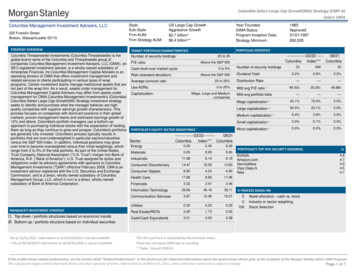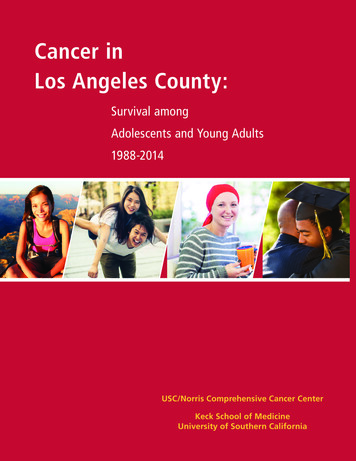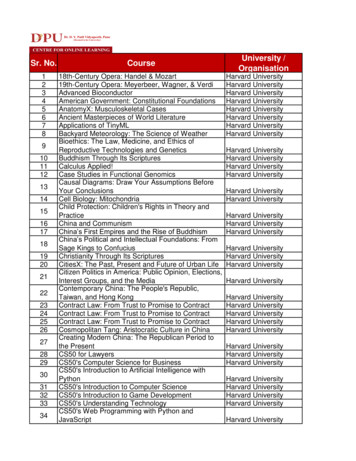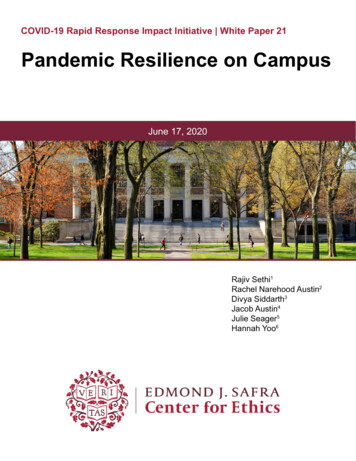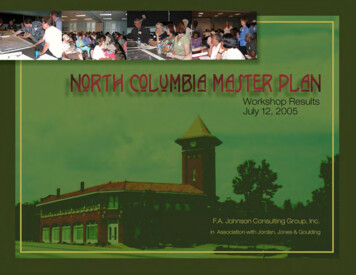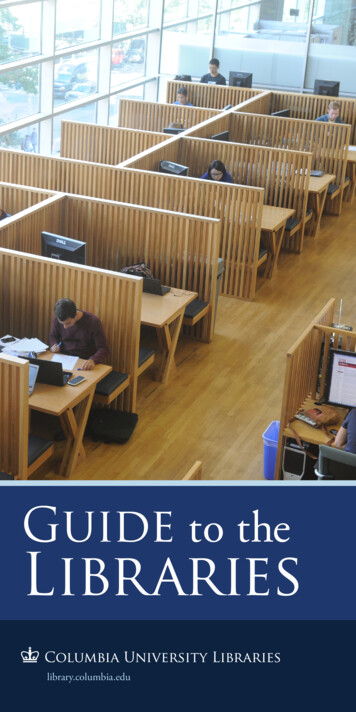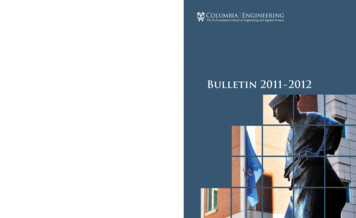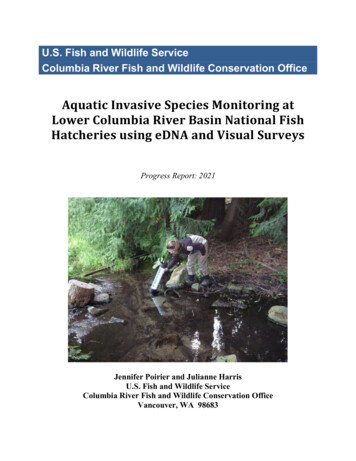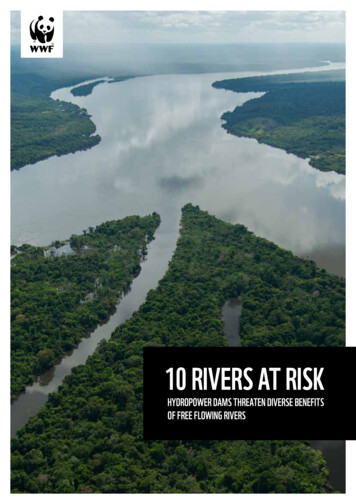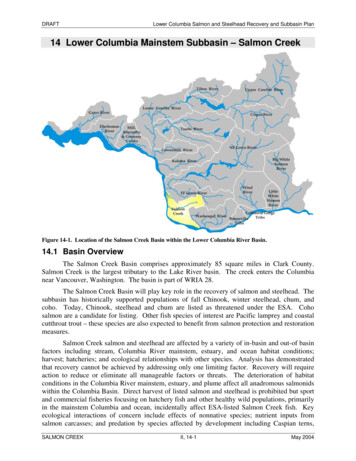
Transcription
DRAFTLower Columbia Salmon and Steelhead Recovery and Subbasin Plan14 Lower Columbia Mainstem Subbasin – Salmon CreekFigure 14-1. Location of the Salmon Creek Basin within the Lower Columbia River Basin.14.1 Basin OverviewThe Salmon Creek Basin comprises approximately 85 square miles in Clark County.Salmon Creek is the largest tributary to the Lake River basin. The creek enters the Columbianear Vancouver, Washington. The basin is part of WRIA 28.The Salmon Creek Basin will play key role in the recovery of salmon and steelhead. Thesubbasin has historically supported populations of fall Chinook, winter steelhead, chum, andcoho. Today, Chinook, steelhead and chum are listed as threatened under the ESA. Cohosalmon are a candidate for listing. Other fish species of interest are Pacific lamprey and coastalcutthroat trout – these species are also expected to benefit from salmon protection and restorationmeasures.Salmon Creek salmon and steelhead are affected by a variety of in-basin and out-of basinfactors including stream, Columbia River mainstem, estuary, and ocean habitat conditions;harvest; hatcheries; and ecological relationships with other species. Analysis has demonstratedthat recovery cannot be achieved by addressing only one limiting factor. Recovery will requireaction to reduce or eliminate all manageable factors or threats. The deterioration of habitatconditions in the Columbia River mainstem, estuary, and plume affect all anadromous salmonidswithin the Columbia Basin. Direct harvest of listed salmon and steelhead is prohibited but sportand commercial fisheries focusing on hatchery fish and other healthy wild populations, primarilyin the mainstem Columbia and ocean, incidentally affect ESA-listed Salmon Creek fish. Keyecological interactions of concern include effects of nonnative species; nutrient inputs fromsalmon carcasses; and predation by species affected by development including Caspian terns,SALMON CREEKII, 14-1May 2004
DRAFTLower Columbia Salmon and Steelhead Recovery and Subbasin Plannorthern pikeminnow, seals, and sea lions. Discussions of out-of-basin factors, strategies, andmeasures common to all subbasins may be found in Volume I, Chapters 4 and 7. This subbasinchapter focuses on habitat and other factors of concern specific to the Salmon Creek Subbasin.Land use in the Salmon Creek/Lake River basin is predominately urban and ruraldevelopment, with nearly the entire Burnt Bridge Creek watershed lying within the Vancouvermetropolitan area. Historical wetlands and floodplains have been converted to residential,commercial, industrial, and agricultural uses. The upper reaches of the Salmon Creek basin havebeen impacted by forestry, agriculture, and rural residential development.Continued population growth is of primary concern in this basin. Major urban centers inthe basin are Vancouver, Orchards, Salmon Creek, Battle Ground, and Ridgefield. The year 2000population, estimated at 252,000 persons is expected to increase to 519,000 by year 2020(LCFRB 2001). Population growth will result in the continued conversion of forestry andagricultural land uses to residential uses, with potential impacts to habitat conditions. It isimportant that growth management policy adequately protect critical habitats and the conditionsthat create and support them.SALMON CREEKII, 14-2May 2004
DRAFTLower Columbia Salmon and Steelhead Recovery and Subbasin PlanLand OwnershipPrivateFederalStateOther public89%4%4%3%Vegetation CompositionLate SeralMid SeralEarly SeralOther ForestNon ForestSALMON CREEKLand OwnershipLand Use / Cover0%6%1%19%71%II, 14-3May 2004
DRAFTLower Columbia Salmon and Steelhead Recovery and Subbasin Plan14.2 Species of InterestFocal salmonid species in the Salmon Creek basin include coho, winter steelhead, andchum. Fall Chinook are considered part of the East Fork Lewis population. The current health orviability is low for winter steelhead and very low for chum and coho. Focal populations need toimprove to a targeted level that contributes to recovery of the species (see Volume I, Chapter 6).For Salmon Creek populations, the objective is to stabilize the populations to no less than thecurrent viability level. The low viability level for winter steelhead provides for a 40-74%probability of persistence over 100 years, and the very low viability level for chum and cohoprovides for a 0-40% probability of persistence over 100 years.Other species of interest in Salmon Creek include coastal cutthroat trout and Pacificlamprey. Regional objectives for these species are described in Volume I, Chapter 6. Recoveryactions targeting focal salmonid species are also expected to provide significant benefits forthese other species. Cutthroat will benefit from improvements in stream habitat conditions forsalmonids. Lamprey are expected to benefit from habitat improvements in the estuary, ColumbiaRiver, and mainstem, and in the Salmon subbasin, although specific spawning and rearing habitatrequirements for lamprey are not well known.Table 14-1.Current viability status of Salmon populations and the biological objective status that isnecessary to meet the recovery criteria for the Cascade strata and the lower Columbia ESU.SpeciesWinter ry lowVery lowNumbers 100 100unknownObjectiveViabilityLowVery lowVery lowNumbers600-1,2001,100-4,200unknownWinter Steelhead– The historical Salmon Creek adult population is estimated from 5008,000 fish. Current natural spawning returns are less than 100 fish. Skamania Hatchery wintersteelhead are released into Salmon Creek for harvest opportunity In-breeding between wild andhatchery winter steelhead is possible, but likely low because of differences in spawn timing.Spawning occurs throughout the Salmon Creek basin, the lower reaches of Gee Creek, WhippleCreek, and Burnt Bridge Creek Spawning time is generally from early March to early June.Juvenile rearing occurs both downstream and upstream of the spawning areas. Juveniles rear fora full year or more before migrating from Salmon Creek.Chum– the historical Salmon Creek adult population is estimated from 10,000-90,000fish. Current natural spawning is estimated at less than 100 fish. Spawning occured in the lowerreaches of the mainstem Salmon Creek, Gee Creek, Whipple Creek, and Burnt Bridge CreekNorth Fork, East Fork, and in Cedar Creek. Spawning occurs from late November throughDecember. Juveniles rear in the lower reaches for a short period in the early spring and quicklymigrate to the Columbia.Coho– The historical Salmon Creek adult population is estimated from 6,000-35,000,with both early and late stock coho produced. Current returns are unknown, but presumed to bevery low. Early stock coho spawn in early to mid-November and late stock from late Novemberto March. There is currently no hatchery coho released into Salmon Creek. Natural spawning canoccur though out the Salmon Creek basin, but principally in the upper mainstem Salmon Creek,and Morgan, Rock, Mill, and Weaver creeks. Potential for coho spawning also exists in nearbySALMON CREEKII, 14-4May 2004
DRAFTLower Columbia Salmon and Steelhead Recovery and Subbasin Planstreams, including Burnt Bridge and Whipple creeks. Juveniles rear for a full year in the SalmonCreek basin before migrating as yearlings in the spring.Coastal Cutthroat– Coastal cutthroat abundance in Salmon Creek has not been quantifiedbut the population is considered depressed. Both andromous and resident form of cutthroat arpresent in the basin. Anadromous cutthroat enter Salmon Creek from July-December and spawnfrom December through June. Most juveniles rear 2-4 years before migrating from their natalstream.Pacific lamprey– Information on lamprey abundance is limited and does not exist for theSalmon Creek population. However, based on declining trends measured at Bonneville Dam andWillamette Falls it is assumed that Pacific lamprey have declined in the Salmon Creek basinalso. Adult lamprey return from the ocean to spawn in the spring and summer. Juveniles rear infreshwater up to seven years before migrating to the ocean.SALMON CREEKII, 14-5May 2004
DRAFTLower Columbia Salmon and Steelhead Recovery and Subbasin PlanFigure 14-2. Summary of habitat limiting factors, population status, expected population improvement trend with existing programs and biological objectives depictedfor the Salmon Creek Basin.SALMON CREEKII, 14-6May 2004
DRAFTLower Columbia Salmon and Steelhead Recovery and Subbasin Plan14.3 Potentially Manageable ImpactsStream habitat, estuary/mainstem habitat, harvest, hatchery and predation effects have allcontributed to reduced salmonid productivity, numbers, and population viability in the SalmonCreek subbasin. The pie charts below represent the relative order of magnitude of quantifiableeffects for each of these factors for each focal species. The preferred recovery scenario targetsan equivalent reduction in each impact factor in proportion to the magnitude of the effect.Population-specific targets are discussed in further detail in Volume I, Chapter 6. Loss of tributary habitat quality and quantity is an important impact for all species. Loss ofestuary habitat quality and quantity is also important to chum. Harvest has a large relativeimpact on fall Chinook and moderate impacts on coho and winter and summer steelhead.Harvest effects on chum are minimal. Harvest is a significant issue for coho, but not so for both chum and winter steelhead. Hatchery impacts are moderate for winter steelhead and coho, but are non-existent for chum. Predation is moderately important to all three species.Fall ChinookChumCohoWinter SteelheadNotAvailableTributary HabitatEstuary HabitatFishingHydro access & passageHatcheryPredationFigure 14-3. Relative contribution of potentially manageable impacts for Salmon Creek populations.SALMON CREEKII, 14-7May 2004
DRAFTLower Columbia Salmon and Steelhead Recovery and Subbasin Plan14.4 Limiting Factors, Threats, and Measures14.4.1Hydropower Operation and ConfigurationThere are no hydro-electric dams in the Salmon Creek Basin. However, Salmon Creekspecies are affected by mainstem Columbia hydro operations and flow regimes which affecthabitat in migration corridors and in the estuary. Mainstem hydro factors and threats areaddressed by regional strategies and measures identified in Volume I.14.4.2HarvestMost harvest of wild Salmon Creek salmon and steelhead occurs incidental to the harvestof hatchery fish and healthy wild stocks in the Columbia estuary, mainstem, and ocean. Thismortality is very low for chum and steelhead, and relatively low for coho. No harvest of chumoccurs in ocean fisheries, there is no chum directed Columbia River commercial fisheries andretention of chum is prohibited in Columbia River and Salmon Creek sport fisheries. Some chumcan be impacted incidental to fisheries directed at coho and winter steelhead. Harvest of SalmonCreek coho occurs in the ocean commercial and recreational fisheries off the Washington andOregon coasts and Columbia River. There is no salmon directed sport fishery in Salmon Creek.Wild coho impacts are limited by fishery management to retain fin-marked hatchery fish andrelease unmarked wild fish. Incidental mortality of steelhead occurs in freshwater commercialfisheries directed at Chinook and coho and freshwater sport fisheries directed at hatcherysteelhead and salmon. All recreational fisheries are managed to selectively harvest fin-markedhatchery fish and commercial fisheries cannot retain hatchery or wild steelhead.Measures to address harvest impacts are generally focused at a regional level to coverfishery impacts accrued to lower Columbia salmon as they migrate along the Pacific Coast andthrough the mainstem Columbia River. The regional measures cover species from multiplewatersheds which share the same migration routes and timing, resulting in similar fisheryexposure. Regional strategies and measures for harvest are detailed in Volume I, Chapter 7. Anumber of regional strategies for harvest involve implementation of measures within specificsubbasins. In-basin fishery management is generally more applicable to steelhead while regionalmanagement is more applicable to salmon. Regional harvest measures with significantapplication to the Salmon Creek Subbasin populations are summarized in the following table:SALMON CREEKII, 14-8May 2004
DRAFTLower Columbia Salmon and Steelhead Recovery and Subbasin PlanTable 14-2. Regional harvest measures from Volume I, Chapter 7 with significant application to the SalmonCreek Subbasin populations.MeasureDescriptionCommentsF.M17Monitor chum handle rate in tributarywinter steelhead.F.M18Monitor and evaluate commercial andsport impacts to naturally-spawningsteelhead in salmon and hatcherysteelhead target fisheries.F.M19Continue to improve gear andregulations to minimize incidentalimpacts to naturally-spawningsteelhead.Maintain selective sport fisheries inOcean, Columbia River, andtributaries and monitor naturallyspawning stock impacts.State agencies would include chum incidental handleassessments as part of their annual tributary sport fisherysampling plan.Includes monitoring of naturally-spawning steelheadencounter rates in fisheries and refinement of long-termcatch and release handling mortality estimates. Wouldinclude assessment of the current monitoring programsand determine their adequacy in formulating naturallyspawning steelhead incidental mortality estimates.Regulatory agencies should continue to refine gear, handleand release methods, and seasonal options to minimizemortality of naturally-spawning steelhead in commercialand sport fisheries.Mass marking of lower Columbia River coho and steelheadhas enabled successful ocean and freshwater selectivefisheries to be implemented since 1998. Markingprograms should be continued and fisheries monitored toprovide improved estimates of naturally-spawningsalmon and steelhead release mortality.F.M2414.4.3HatcheriesAs noted in the regional strategies, hatcheries can adversely affect wild salmon andsteelhead populations in several ways. These include domestication or the reduction in thefitness of wild fish due to interbreeding with hatchery fish, direct competition between wild andhatchery fish for habitat and nutrients, and the introduction of disease. Hatcheries can also assistin recovery efforts by providing fish needed to reestablish extirpated populations or to augmentwild populations that have reached critically low levels.There are no hatcheries operating in the Salmon Creek Basin. Skamania Hatchery wintersteelhead are released into lower Salmon Creek to provide harvest opportunity. SkamaniaHatchery steelhead are a composite stock and are genetically different from the naturallyproduced steelhead in Salmon Creek. The main threats from hatchery steelhead are potentialdomestication of the naturally produced steelhead as a result of adult interactions or ecologicalinteractions between natural juvenile salmon and hatchery released juvenile steelhead.Table 14-3.Salmon Creek hatchery Production.HatcherySkamanaiaRelease LocationSalmon CreekWinter Steelhead20,000Regional hatchery strategies and measures are focused on evaluating and reducingbiological risks and increasing the benefits to natural populations. Regional hatchery measuresidentified in Volume I, Chapter 7 with specific applications within the Salmon Creek Subbasinare summarized in the following table:SALMON CREEKII, 14-9May 2004
DRAFTLower Columbia Salmon and Steelhead Recovery and Subbasin PlanTable 14-4.Regional hatchery measures from Volume I, Chapter 7 with specific implementation actionsin the Salmon Creek Subbasin.MeasureDescriptionCommentsH.M32Juvenile release strategies to minimizeinteractions with naturally spawningfish.Mark hatchery steelhead.Release strategies are aimed at reducing or avoidinginteractions with wild steelhead, fall Chinook, coho byrelease timing and release location strategies.Marking hatchery fish allows for identification ofhatchery fish in the natural spawning grounds and atcollection facilities which enables accurate accountingof wild fish. Marking also enables selective fisheries toretain hatchery fish and release wild fish.H.M3414.4.4Ecological InteractionsEcological interactions focus on how salmon and steelhead, other fish species, andwildlife interact with each other and the subbasin ecosystem. Salmon Creek salmon andsteelhead are affected throughout their lifecycle by ecological interactions with non nativespecies, food web components, and predators. Interactions are similar for Salmon Creekpopulations to those of most other subbasin salmonid populations. Ecological Interactions areaddressed by regional strategies and measures identified in Volume I.14.4.5Habitat – Estuary and Lower Columbia MainstemConditions in the Columbia River mainstem, estuary, and plume affect all anadromoussalmonid populations within the Columbia Basin. A variety of human activities in the mainstemand estuary have decreased both the quantity and quality of habitat used by juvenile salmonids.These include floodplain development; loss of side channel habitat, wetlands and marshes; andalteration of flows due to upstream hydro operations and irrigation withdrawals. Effects aresimilar for Salmon Creek populations to those of most other subbasin salmonid populations.Effects are likely to be greater for chum and fall Chinook than spring Chinook, steelhead, andcoho. Estuary and mainstem effects on Salmon Creek salmon and steelhead populations areaddressed by regional strategies and measures identified in Volume I and the ColumbiaMainstem and Estuary Subbasin sections of Volume II.14.4.6Habitat – Subbasin Streams and WatershedsDecades of human activity have significantly altered watershed processes and reducedboth the quality and quantity of habitat needed to sustain viable populations of salmon andsteelhead. Moreover, with the exception of fall Chinook, stream habitat conditions within theSalmon River basin have the greatest impact on the health and viability of salmon and steelheadrelative to the other limiting factors and threats discussed in this chapter.Subwatersheds, reaches, and habitat attributes have been prioritized for protection and/orrestoration based on the plan’s biological objectives, fish distribution, critical life history stages,current habitat conditions, and potential fish population performance. Priority areas for habitatpreservation and restoration are identified in Figure 14-4. A summary of the primary habitatlimiting factors and threats are presented in Table 14-6. Habitat measures and related informationare presented in Table 14-7. Results of IWA watershed process modeling are depicted forsubwatersheds in Figure 14-5. Reach- and subwatershed-scale limiting factors generated fromthe technical assessment are included in Table 14-5. Details on species-specific spatial prioritiesand limiting factors at the subbasin level may be found in Volume II of the TechnicalSALMON CREEKII, 14-10May 2004
DRAFTLower Columbia Salmon and Steelhead Recovery and Subbasin PlanFoundation. A description of the methodology used to generate composite (multi-species) reachand subwatershed priorities can be found in the introduction to this volume of the recovery plan.The Salmon Creek basin contains no Tier 1 or 2 reaches, which reflects that SalmonCreek salmonid populations are not expected to be recovered to a high level of viability forrecovery planning purposes. It is important for recovery planning, however, that thesepopulations do not decline further, which will be a challenging objective considering thecontinued intensive development of this basin. The areas with the greatest current or potentialcontribution to focal salmonid population health and productivity are listed below. Lower mainstem Salmon & tributaries – Salmon 12-16; Suds 1-2Upper mainstem Salmon & tributaries – Salmon 20-32; Morgan 1; Rock 1, 5, 7The following paragraphs provide a brief overview of each of these priority areas,including species most affected, land-use threats, and the general type of measures that will benecessary for recovery. Additional detail can be found in the tables and figures that follow.While reach level habitat conditions often result from local factors, they are also affectedor shaped by systemic watershed processes. Limiting factors such as temperature, high and lowflows, sediment input and large woody debris recruitment are often affected by or result fromupstream conditions and degraded watershed processes. Access to key reaches may also beaffected by barriers that occur downstream of a reach. Accordingly, restoration of a priorityreach may require action outside the targeted reach. The IWA analysis was used to identifypotential upstream watershed areas that could influence reach level habitat attributes. EDT wasused to allow a relative comparison of reaches and habitat attributes within a reach.The lower mainstem Salmon Creek reaches with the greatest potential production arelocated in the vicinity of Salmon Creek County Park, near the I-5 crossing. These reacheshistorically provided productive habitats for fall Chinook, chum, coho, and winter steelhead.This area is heavily impacted by urban and rural development in the expanding Vancouvermetropolitan area. Effective recovery measures will involve land-use planning that adequatelyprotects habitat-forming processes in sensitive areas (wetlands, floodplains, riparian corridors).Restoration of riparian areas along these and upstream reaches will also yield important benefits.A few potentially productive reaches for coho and winter steelhead are located on themainstem between the Hwy 503 crossing and Salmon Falls. Rock Creek and other, smaller,tributaries (e.g., Morgan Creek) also contain potentially productive habitats for coho. Thesereaches are heavily impacted by agricultural uses and rural residential development. As with thelower basin, the upper basin is expected to continue to develop rapidly. In light of the continuedgrowth, there needs to be emphasis on land-use planning that provides adequate protections tosensitive areas. In addition, riparian and floodplain restoration that targets impacts related tograzing and rural development will yield important benefits to salmonid habitat.SALMON CREEKII, 14-11May 2004
DRAFTLower Columbia Salmon and Steelhead Recovery and Subbasin PlanReach TiersSubwatershedGroupsT ie r 1T ie r 2T ie r 3T ie r 4Figure 14-4. Reach tiers and subwatershed groups in the Salmon Creek Basin. Tier 1 reaches and Group Asubwatersheds represent the areas where recovery actions would yield the greatest benefits withrespect to species recovery objectives. The subwatershed groups are based on Reach Tiers.Priorities at the reach scale are useful for identifying stream corridor recovery measures. Prioritiesat the subwatershed scale are useful for identifying watershed process recovery measures.Watershed process recovery measures for stream reaches will need to occur within the surrounding(local) subwatershed as well as in upstream contributing subwatersheds.SALMON CREEKII, 14-12May 2004
DRAFTLower Columbia Salmon and Steelhead Recovery and Subbasin PlanFigure 14-5. IWA subwatershed impairment ratings by category for the Salmon Creek Basin. Watershed process impairment ratings are based onlandscape conditions that influence the hydrologic regime, the sediment regime, and riparian function. See Volume II and Volume V of theRecovery Plan Technical Foundation for additional information.SALMON CREEKII, 14-13May 2004
DRAFTLower Columbia Salmon and Steelhead Recovery and Subbasin PlanTable 14-5. Summary Table of reach- and subwatershed-scale limiting factors in priority areas. The table isorganized by subwatershed groups, beginning with the highest priority group. Species-specificreach priorities, critical life stages, high impact habitat factors, and recovery emphasis(P preservation, R restoration, PR restoration and preservation) are included. Watershedprocess impairments: F functional, M moderately impaired, I impaired. Species abbreviations:ChS spring Chinook, ChF fall Chinook, StS summer steelhead, StW winter steelhead.90109C90106SALMON nnel1 3Salmon14 ASalmon14 BSalmon14 dsCulv5TenneyCr(LBtrib1)StWCohoStWHigh priority reachesby ritical life stages byspeciesegg incubationsummer rearingwinter rearingadult holdingegg incubationfry colonizationsummer rearingwinter rearingPreservationHigh impact habitat or restorationfactorsemphasischannel stabilitytemperatureflowsedimentkey habitat quantityRchannel stabilityhabitat diversityflowsedimentfoodkey habitat 1RBtrib11-1Salmon29Salmon31egg incubationfry colonizationsummer rearingwinter rearingspawningegg incubationfry colonizationsummer rearingwinter rearingjuvenile migrant mon23Salmon24Salmon26RBtrib9-1egg incubationfry colonizationsummer rearingegg incubationfry colonizationsummer rearingwinter rearinghabitat diversitysedimentRegg incubationsummer rearingwinter rearingegg incubationsummer rearingwinter rearingspawningegg incubationfry colonizationadult holdingspawningegg incubationfry colonizationadult migrantadult holdingegg incubationfry colonizationsummer rearinghabitat diversitysedimentRhabitat diversitysedimentRchannel stabilityhabitat diversitysedimentkey habitat quantityhabitat diversitysedimentharassmentkey habitat quantityRhabitat diversitytemperaturepredationflowsedimentchannel stabilityhabitat Salmon20ChFSalmon14 ASalmon14 BSalmon14 CSalmon16Salmon13Salmon14 ASalmon14 BSalmon16ChumStWCohoSalmon13Salmon14 ASalmon14 BSalmon14 CSalmon16Lalonde1Salmon12Salmon13Salmon14 ASalmon14 BSalmon16Suds1Suds2spawningegg incubationfry colonizationsummer rearingwinter rearingjuvenile migrant (age-0)juvenile migrant (age-1)II, 14-14habitat diversitysedimentPRchannel stabilityhabitat diversitysedimentkey habitat 0108Reaches withinsubwatershedBakerCr1 (LBtrib3-1)BakerCr2 (LBtrib3-2)BakerCr3 (LBtrib3-3)Fishway1Morgan1Morgan2Morgan3 AMorgan3 gyWatershedWatershedprocessesprocesses (local) (watershed)IMIIMIMMIMIMMIMIMIIMIMIMMIMIMMRRMay 2004
DRAFTLower Columbia Salmon and Steelhead Recovery and Subbasin Plan90110D9010490101SALMON CREEKHigh priority reachesby lChumStWCritical life stages byspeciesPreservationHigh impact habitat or entAllCohoHydrology9011790115Reaches l3Mill4Mill5RBtrib2-1 GroupSedimentWatershedWatershedprocessesprocesses (local) (watershed)MIInonenonenonenonenonenonenonenoneII, 14-15May 2004
DRAFTLower Columbia Salmon and Steelhead Recovery and Subbasin PlanTable 14-6. Salmonid habitat limiting factors and threats in priority areas. Priority areas include the lower Salmon mainstem (LM) and uppermainstem Salmon & tributaries (UM). Linkages between each threat and limiting factor are not displayed – each threat directly andindirectly affects a variety of habitat factors.Limiting FactorsThreatsLMHabitat connectivityBlockages to off-channel habitatsHabitat diversityLack of stable instream woody debrisAltered habitat unit compositionLoss of off-channel and/or side-channel habitatsChannel stabilityBed and bank erosionChannel down-cutting (incision)Riparian functionReduced stream canopy coverReduced bank/soil stabilityExotic and/or noxious speciesReduced wood recruitmentFloodplain functionAltered nutrient exchange processesReduced flood flow dampeningRestricted channel migrationDisrupted hyporheic processesStream flowAltered magnitude, duration, or rate of changeWater qualityAltered stream temperature regimeExcessive turbidityBacteriaReduced dissolved oxygen concentrationsSubstrate and sedimentLack of adequate spawning substrateExcessive fine sedimentEmbedded substratesBiological processesHarassmentSALMON CREEKUMLMUMAgriculture/grazingClearing of vegetationRiparian grazingFloodplain fillingUrban/suburban/rural developmentClearing of vegetationFloodplain fillingIncreased impervious surfacesIncreased drainage networkRoads – riparian/floodplain impactsLeaking septic systemsChannel manipulationsBank hardeningChannel straighteningArtificial confinementDredge and fill activitiesMiningClearing of vegetationChannel and/or floodplain substrate removalFloodplain fillingIncreased water surface areaRecreationRiver recreation (harassment)II, 14-16May 2004
DRAFTLower Columbia Salmon and Steelhead Recovery and Subbasin PlanTable 14-7. Habitat measures in priority areas, with reference to limiting factors addressed, threats addressed, target species, and estimated time untilbenefits would be realized (time). Tier 1 and 2 reaches, or other areas of known priority, are listed under
a full year or more before migrating from Salmon Creek. Chum- the historical Salmon Creek adult population is estimated from 10,000-90,000 fish. Current natural spawning is estimated at less than 100 fish. Spawning occured in the lower reaches of the mainstem Salmon Creek, Gee Creek, Whipple Creek, and Burnt Bridge Creek
